Related sites:
Newsletter: Perspectives on Power Platform
Company: Niiranen Advisory Oy

In CRM 2013 we now have the option of setting a workflow to be run synchronously, also known as a real-time workflow. This opens up great new possibilities to leverage workflows in designing automated processes and providing immediate feedback to the end user when CRM data is created or updated. Having the workflow process executed in real-time also provides one additional capability that traditional, asynchronous workflows can’t handle: stopping the transaction from taking place.
Similar to synchronous plug-ins, real-time workflows can present a Business Process Error dialog to the user when the operation being performed is breaking the rules of the configured business logic. As the real-time workflows execute in the current transaction, they have the power to roll back the changes that the user is trying to perform, whereas an asynchronous workflow could only observe what had already taken place.
How does this work in practice? Let’s explore the feature by setting up a very simple workflow rule to verify the owner of a record, in this case the Project Manager (owner) of a custom Project entity. When creating the workflow we’ve unchecked the “run this workflow in the background (recommended)” checkbox and thus defined it to run in real time. (If you forgot to do this, just reach for the “Convert to a real-time workflow” button on the toolbar, as the form checkbox can’t be edited directly). We’ll attach the workflow to the assign event of the entity.
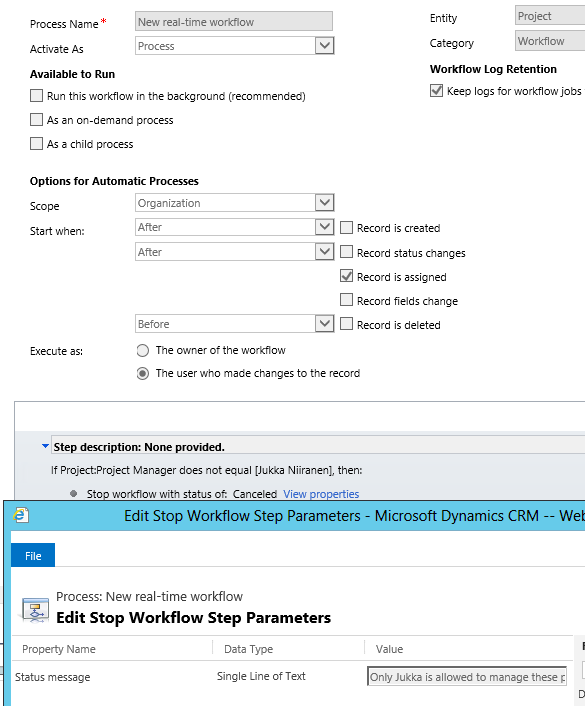
In the workflow rule criteria we’ll perform a check that the Project Manager has the necessary qualifications for the job. If not, we will stop the workflow and set its status to be Canceled. What’s new compared to CRM 2011 workflows is that we can set a Status Message for the workflow cancellation. Rather than just being a behind the scenes log entry, this text field’s contents will actually be presented to the user if the real-time workflow process is cancelled. This is therefore the place where you should provide instructions on why the cancellation took place and how the user can avoid it.
Let’s activate our workflow, go to an existing project record and attempt to assign it to a less competent CRM project manager, like Teppo:
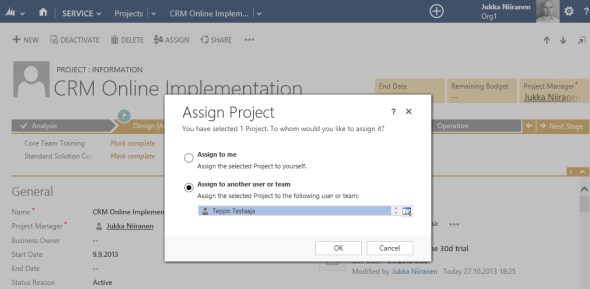
After we click OK on the assign dialog, a Business Process Error dialog is presented, along with our status message text that explains why the operation cannot be allowed.
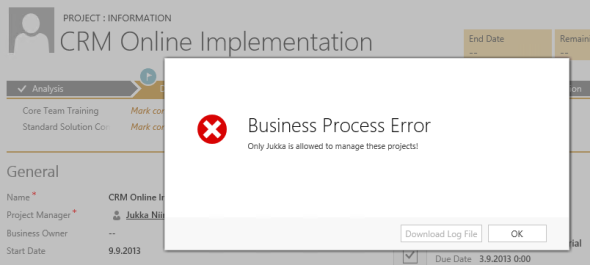
The transaction is rolled back, which means the assignment never takes place and our project remains in the hands of a certified professional. CRM workflows save the day!
Here’s a couple of considerations to keep in mind with the above example:
What kind of real life scenarios would then require the system to throw a Business Process Error at the user? Let’s think about a typical CRM implementation where the customer data is integrated with an ERP system. As long as you’re working with prospects that haven’t placed an order yet, there shouldn’t be too many limitations in place in CRM on how you can update the data. Once the account information is transferred to the ERP system for the purpose of order and invoice processing, the need for restricting certain operations on the account records will likely arise.
Let’s assume that we’re identifying the ERP integrated accounts through the Account Number field on the CRM account entity. If the field contains data, then this is a record where updates need to be restricted. By leveraging the new CRM 2013 Business Rules we can configure the fields on the form to be disabled if an account number exist. But what about updates that are not performed as changes of form field values? This is an area the Business Rules can’t touch, but with real-time workflows we may be able to add custom business logic into CRM that would have traditionally required a .NET developer to write plug-ins for us.
As an example, we’d like to ensure that no account records can be deactivated in CRM if they exist in the ERP system. The deactivation might take place through a data management operation like merging duplicate records, in which the master record is left in active status and the child record gets deactivated. We can’t directly trigger the workflow process from the clicking of the Merge button on the account view Command Bar, but we can set our business logic to be run on the status change event. Let us therefore build a new “Stop account merge” real-time workflow rule with the following criteria:

We’re actually performing this after the deactivation has already taken place, but that doesn’t matter, because we’ll still be able to cancel the whole operation. We’ll look for any accounts that have gone through a status change event and are now in an Inactive state. If the account record has an account number, we’ll stop the workflow with status of Canceled and provide a message to the user explaining what are the proper steps to take in getting everything updated correctly both in the CRM and ERP systems.
Let’s try this first on a single account record. When we click on the Deactivate button on the account form’s Command Bar, the Business Process Error dialog is presented to us, along with the message we defined in the workflow. No deactivation can take place, so the account is returned back to active status. More precisely, the account record status never changes, as can be verified from the audit history log (if enabled).
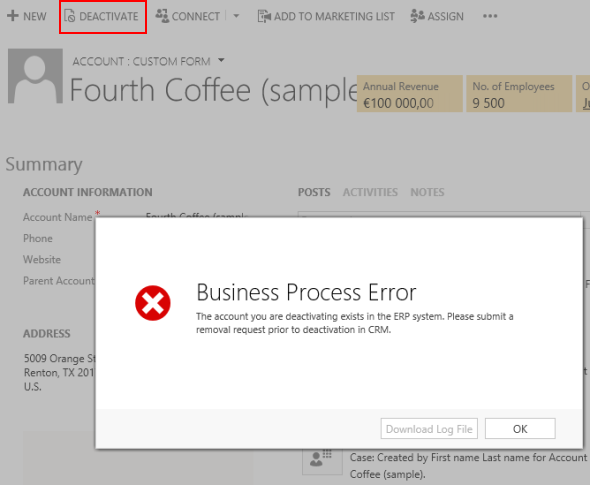
Great, now let’s move on to the Merge scenario and try to combine two active accounts with account numbers into a single account. We’ll select the accounts, click Merge, go through the Merge Records dialog, defy all the instructions given to us by the CRM key user of our organization and attempt to merge two separate ERP accounts in CRM. Once we hit the OK button for the merge to be performed, the Business Process Error dialog jumps to the rescue and stops the operation.
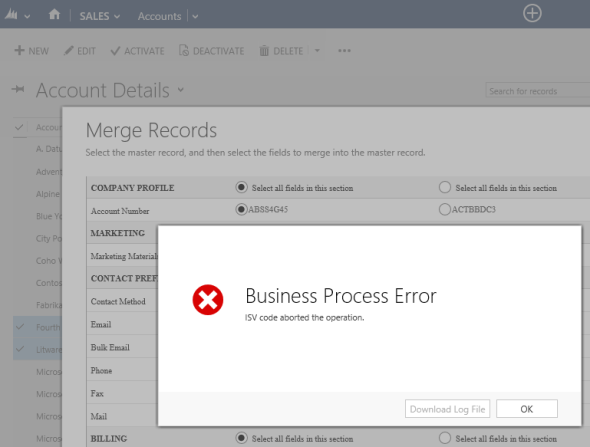
Hey, wait a second, why’s the text in the Business Process Error window different now? “ISV code aborted the operation”, what does that mean? Well, it seems that because we’re not actually performing the status change action directly on the record but rather leverage the built-in Merge Records dialog and its associated business logic for record deactivation, our status message text doesn’t reach that screen. The event itself does “bubble up”, though, so stopping the status change also rolls back the entire transaction and none of the fields on the records being the targets of the merge operation change. That’s the important part, after all.
Let’s have a look at one more use case for the real-time workflow error messages before I let you get on with your browsing. The previous example covered an event that Business Rules weren’t able to control, due to the fact that they execute only on the entity form. In a CRM & ERP integration scenario you may however need to have the account record fields locked on more places than just the form. Remember that any updates the user would perform through other means, such as Excel export/re-import or a custom client app would not trigger the Business Rules that are essentially just client side scripts on the form. If you build this logic onto the server side as plug-ins or workflows, though, no one can perform an operation that would violate the rules (just ensure there’s always some supported way for performing the necessary updates & don’t block you integrations while creating these gatekeeper workflows).
One built-in form where the Business Rules don’t run is the mobile form. Utilized in both the Mobile Express browser version as well as the mobile apps for Windows Phone, iPhone and Android, these forms offer a limited set of capabilities for reading, creating and updating records. While you can set a field on the mobile forms to be read-only, you can’t build any conditional logic to determine when the field should be locked.
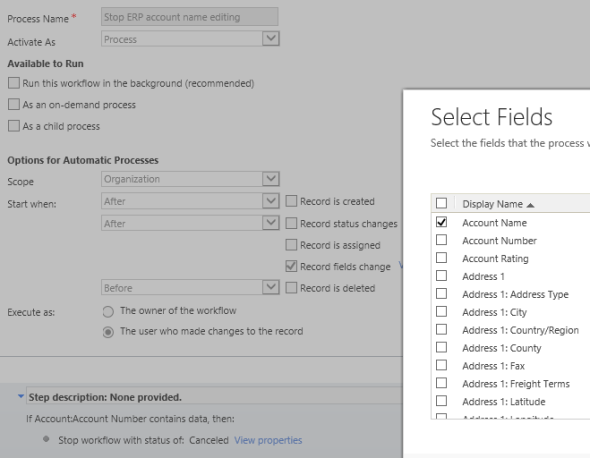
 Let’s assume you want to allow people to quickly create and edit accounts through their mobile device, but you also want to lock down the account names on records that have been synchronized to the ERP system. To meet the first requirement you’ll need to leave the field on the form in an editable mode. To stop someone from accidentally overwriting the name of your biggest customer account with “Aasd,abhoignldfiiiiii” or other gibberish when fumbling around with CRM on their tiny little iPhone screens, you could create a real-time workflow to guard these fields from unwanted input. Have it run on the field change events, check whether it’s an ERP account with an account number and then cancel the event if necessary.
Let’s assume you want to allow people to quickly create and edit accounts through their mobile device, but you also want to lock down the account names on records that have been synchronized to the ERP system. To meet the first requirement you’ll need to leave the field on the form in an editable mode. To stop someone from accidentally overwriting the name of your biggest customer account with “Aasd,abhoignldfiiiiii” or other gibberish when fumbling around with CRM on their tiny little iPhone screens, you could create a real-time workflow to guard these fields from unwanted input. Have it run on the field change events, check whether it’s an ERP account with an account number and then cancel the event if necessary.
Opening up the Mobile Express UI (just append the CRM organization URL with /m/ to access this version) and trying to edit the account name field now gives the same kind of notification as the full browser client. The Business Process Error dialog window doesn’t seem to have any mobile optimized version, but again it gets the basic job done by stopping the update. I didn’t test this on the Dynamics CRM mobile apps, but seeing how at least on Android the app is almost identical to the Mobile Express browser version I’d imagine the experience is similar there as well.
OK, that’s the end of my experiments with real-time workflow process error messages for now. I’m sure that there will continue to be a need for more advanced solutions for controlling user data input that will involve hiding UI components through scripts or enforcing business logic through plug-ins, especially if the transaction volumes are expected to be high. The new workflow capabilities do however provide a quick way to configure custom error prompts and stop unwanted events when experimenting with the design options of your solutions and iterating your way towards the final production system.
Great work Jukka.
Great Post, Jukka!
This helps clarify things a lot for me. Appreciate the time you put into this.
Regards,
Mike
Hang on I thought the whole point of Business Rules was “write once – works everywhere”? Import/export I understand but I thought Business Rules DID work on the MOCA client. I have to say I’m pretty confused by the different mobile clients/apps though so have I just got things mixed up?
Simon, Business Rules do work on the MOCA client for Windows 8 and iPad (or at least they should, haven’t tested them yet). The “real mobile clients”, meaning smartphone apps to carry with you in your pocket (Windows Phone, iPhone, Android) are to my knowledge using the same mobile form definitions as Mobile Express and do not support any scripts. You can have role based forms on the mobile browser/app, but any client side extensions are not available on the CRM mobile form configuration UI.
I see thanks yet again Jukka!
I’m sure I won’t be the only person confused by the “write once – use anywhere” strapline so I think this clarification will be especially useful.
Thank you for this article… It’s great!!
[…] the new capabilities that Microsoft Dynamics CRM 2013 has introduced for workflow processes: showing error messages with real-time workflows. I covered examples of record assignment, merging duplicate accounts and stopping unwanted updates […]
Thanks for the post Jukka,
Very useful. I guess I can now understand why Form side On Save / On Edit ‘Duplicate Detection’ functionality was switched-off in CRM 2013. It seems using real-time workflow gives you much more flexibility and range to perform detailed duplicate detection..
Thanks again,
Vijay
[…] (including the record creation in our example). This is what allows the real-time workflows to abort the operation and it also ensures that another competing workflow doesn’t get a chance to mess with the […]
Great post Jukka!
I was missing the status part, wondering why it wouldn’t alert when I stop the workflow with a status of ‘succeeded’. Good to know that we can stop the process without throwing an error though.
Jukka, thanks again for the documentation here. It is a huge win as we walk through process enhancements to be able to back reference these entries as a reference guide for process refinement.
Regarding: ‘Hey, wait a second, why’s the text in the Business Process Error window different now? “ISV code aborted the operation”, what does that mean?’
You don’t really explain what this error means. Just because the operation is halted doesn’t mean it was halted for the right reasons.
We are getting this error when trying to merge certain pairs contacts. In this case we DO want the merge and deactivation to succeed and it’s not. Based on this article, I’ll see if there are any real-time workflows for the status change of a contact that might be in conflict with successful merges. But, I’d really like to know how I can dig further to prevent this ‘ISV code aborted the operation’ errors.
Andy, the “ISV code aborted the operation” message isn’t specific to real-time workflows only. In fact, prior to CRM 2013 it was only possible to create this message via plugin extensions. I suspect that the reason why you are seeing this message during a merge operation is due to either a third party add-on (developed by an “independent software vendor” a.k.a. ISV) or a custom plugin that has been developed specifically for your CRM environment.
Record merge operations are a common area where error messages like this may occur, since the merge process is not only updating the selected records (in this case contacts) but also any of the child records that are moved under the active record when the duplicate record is deactivated. These would include activities where the contact is an activity party (email sender, appointment attendee, regarding object) as well as any default or custom entities that have a lookup field referencing the contact. Any one of these entities might have a plugin step registered for an event that the merge process triggers, which may then lead to the “ISV code aborted the operation” message being thrown if the plugin logic does not allow the record update to be performed. I would therefore suggest investigating what child records these contact records have and then looking at the plugins / ISV add-ons related to these entities.
Thanks for the post, its very informative.
Great Article..It was very informative..I need more details from your side..include some tips..I am working in Erp In India
Excellent post! Is there any way to change the “Business Process Error” huge title?
Unfortunately, no. The errors will always remain scary looking.
If my synchronous workflow calls a child workflow performed on a child record and the child record encounters a rule error, the user isn’t seeing this error message so they never know it was encountered. Any way around this?
Deb, I’m not sure if there’s a way to get both the parent and child entity workflows to run within the same transaction, which is what would be needed for the error message to be shown. The scenario sounds so complex that you’d probably need to develop a plugin for it, or at least build custom workflow activities that could execute the logic within a single workflow that’s now implemented in the two separate workflow processes.
Hi Jukka
I am creating this type of workflow but it shows error that your real time workflow is failed with error and then show that message which i want please help me
Thank you Jukka. Even today, 8 years after your post it was really useful to learn.